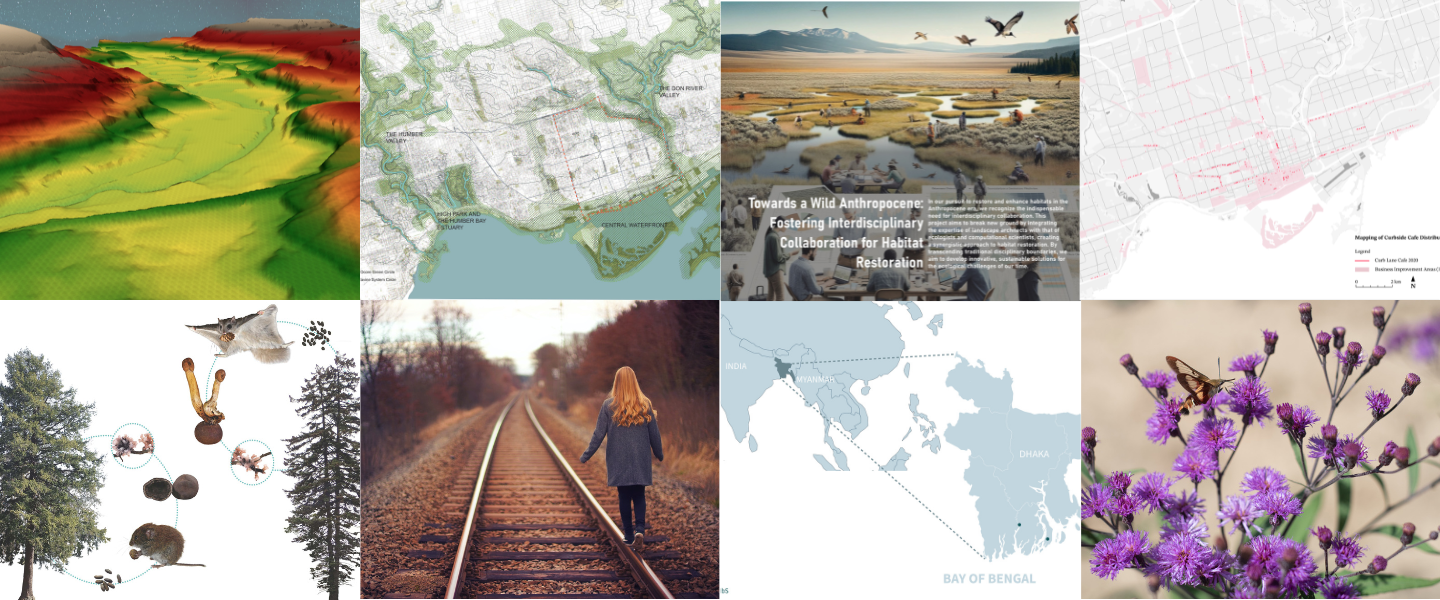
Landscape Architecture Canada Foundation (LACF) is pleased to announce the recipients of funding in the 2024 Research Grants Program in support of research, communication and scholarship. This year, 6 professional awards and 2 student awards were approved by the jury.
The grants awarded for 2024 cover a broad range of topics and tackle issues important to the profession. The proposals were adjudicated and awarded by a National Jury composed of six individuals from public, private and academic practices areas, representing the different regions of Canada.
2024 Grants Recipients
#188: Unveiling hidden relationships: Exploration of tree ecology and multispecies interconnectedness
Heather Schibli, Awarded $6,150 and the Donald Graham Grant
 In our own discipline of landscape architecture, questions about biodiversity unfold with plant provenance, native vs non-native species, invasive species, and landscape aesthetics. Much of the discussion around biodiversity is grounded in simplified and sometimes binary assumptions about species. By compartmentalizing life into units, we overlook systemic factors, such as the many relationships plants have with their environments and fellow life forms. This book will highlight a few of the many relationships that trees engage in with various species, including humans. Image rich, this volume embraces the complexities and inner workings of our biosphere.
In our own discipline of landscape architecture, questions about biodiversity unfold with plant provenance, native vs non-native species, invasive species, and landscape aesthetics. Much of the discussion around biodiversity is grounded in simplified and sometimes binary assumptions about species. By compartmentalizing life into units, we overlook systemic factors, such as the many relationships plants have with their environments and fellow life forms. This book will highlight a few of the many relationships that trees engage in with various species, including humans. Image rich, this volume embraces the complexities and inner workings of our biosphere.
Photo credits: Robert L. Anderson, Alex Badyaev, Chris Maser, Heather Schibli, Ryan Stephens, Richard Tehan.
#189: Towards a Wild Anthropocene: Fostering Interdisciplinary Collaboration for Habitat Restoration
Stephen Hews, Awarded $10,000
 In our pursuit to restore and enhance habitats in the Anthropocene era, we recognize the indispensable need for interdisciplinary collaboration. This project aims to break new ground by integrating the expertise of landscape architects with that of ecologists and computational scientists, creating a synergistic approach to habitat restoration. By transcending traditional disciplinary boundaries, we aim to develop innovative, sustainable solutions for the ecological challenges of our time.
In our pursuit to restore and enhance habitats in the Anthropocene era, we recognize the indispensable need for interdisciplinary collaboration. This project aims to break new ground by integrating the expertise of landscape architects with that of ecologists and computational scientists, creating a synergistic approach to habitat restoration. By transcending traditional disciplinary boundaries, we aim to develop innovative, sustainable solutions for the ecological challenges of our time.
#190: Utilizing big data to uncover the impacts of temporary outdoor dining design on encouraging active travel behaviours –multiyear evidence using Toronto CaféTO as an example
Qiwei Song & Meikang Li, Awarded $6,300
 This research explores the dynamic relationship between temporary outdoor dining program and public bikeshare usage, using Toronto' s CaféTO as a case study. It leverages extensive multi-year micro-mobility data, capturing the shifts in travel behaviors triggered by the COVID-19 pandemic. Our study aims to unravel the longitudinal impacts of CaféTO' s design elements on active travel patterns in the built environment. Such detailed, location-specific examination of effects is further enriched by investigating social media data. The outcomes will be instrumental in directing sustainable landscape development and fostering active travel, contributing to the creation of future healthier and more vibrant cities.
This research explores the dynamic relationship between temporary outdoor dining program and public bikeshare usage, using Toronto' s CaféTO as a case study. It leverages extensive multi-year micro-mobility data, capturing the shifts in travel behaviors triggered by the COVID-19 pandemic. Our study aims to unravel the longitudinal impacts of CaféTO' s design elements on active travel patterns in the built environment. Such detailed, location-specific examination of effects is further enriched by investigating social media data. The outcomes will be instrumental in directing sustainable landscape development and fostering active travel, contributing to the creation of future healthier and more vibrant cities.
#191: Reclaiming the Passive Voice: Stories of Women Who Leave Landscape Architecture
Van Thi Diep, Awarded $10,000 and the Gunter Schoch Grant
 Inspired by The Missing 32%, a gender equity initiative created by the AIA in 2012, this project explores the missing voices of women in landscape architecture. These voices are not found in statistics or equity campaigns but in the act of giving space to the stories of women who have left or are in the process of leaving the profession. In a patriarchal society, what is deemed “valuable” feeds a cycle of normative conditions but by seeking out the most “useless” stories in the eyes of a wounded system, we disturb and heal an old paradigm of conditional worthiness.
Inspired by The Missing 32%, a gender equity initiative created by the AIA in 2012, this project explores the missing voices of women in landscape architecture. These voices are not found in statistics or equity campaigns but in the act of giving space to the stories of women who have left or are in the process of leaving the profession. In a patriarchal society, what is deemed “valuable” feeds a cycle of normative conditions but by seeking out the most “useless” stories in the eyes of a wounded system, we disturb and heal an old paradigm of conditional worthiness.
Image credit: Photo by Johannes Plenio on Unsplash
#192: Clarifying the Relationship Between Plant Provenance and Native Insect Pollinator Communities
Liam Doyle, Awarded $2,500 in Student Grants

Landscape architects are recognizing that one Rudbeckia is not necessarily very much like another, a fact that pollinators may know intuitively. A plant’s ability to support local insect pollinator communities seems to be related to its geographic lineage. My goal is to understand the strength of that relationship, relative to confounding site characteristics like microclimate and plant community composition. This research will help clarify the ecological function of locally sourced plants in landscape projects, and, I sincerely hope, help more designers understand why supporting native biodiversity requires adapting our practice to consider not just plant species but also plant source.
#193: Ravine Reconnect: Restoring Landscape Connectivity in a Growing Metropolis
Sonja Vangjeli, Awarded $6,500
 Toronto’s lakefront and ravine landscapes are its most valuable assets, yet they are not understood holistically like Chicago’s or Boston’s Metropolitan Park Systems. Despite a strong legacy of conservation, many gaps still exist, particularly through lower income neighborhoods where access to green space is needed the most.
Toronto’s lakefront and ravine landscapes are its most valuable assets, yet they are not understood holistically like Chicago’s or Boston’s Metropolitan Park Systems. Despite a strong legacy of conservation, many gaps still exist, particularly through lower income neighborhoods where access to green space is needed the most.
Building on the work of TRCA and City of Toronto’s Ravine Strategy, this online Story Map and design research studio will create an image of Toronto’s Potential Metropolitan Park System in the public imagination, helping to cultivate a community of advocates, and a suite of creative solutions for restoring landscape connectivity across the growing city region.
#194: Using River Builder as a tool for riverscape design and flood risk management: A case study for Sackville River in Bedford, Nova Scotia
 Corey Dawson, Awarded $10,000 and the Sustainable Buildings Canada Grant
Corey Dawson, Awarded $10,000 and the Sustainable Buildings Canada Grant
Nature-based solutions to riverscape design is a concept aimed at building system resilience and  promoting sustainable development and ecological conservation. Collaboration is needed for resilient riverscape design and landscape architects are well-suited for balancing interdisciplinary objectives for restoration planning. Advancements in 3D design tools available to non-geomorphologists may be valuable for landscape architectural communication, allowing riverscape scenarios to be generated in an interactive digital environment for decision-making processes. Digital grading designs can be tested for flood management, strategically adjusted for site requirements, and presented to the community as a more comprehensible 3D surface to advance visual communication and professional collaboration.
promoting sustainable development and ecological conservation. Collaboration is needed for resilient riverscape design and landscape architects are well-suited for balancing interdisciplinary objectives for restoration planning. Advancements in 3D design tools available to non-geomorphologists may be valuable for landscape architectural communication, allowing riverscape scenarios to be generated in an interactive digital environment for decision-making processes. Digital grading designs can be tested for flood management, strategically adjusted for site requirements, and presented to the community as a more comprehensible 3D surface to advance visual communication and professional collaboration.
#195: Nature-based Solutions for Climate Resilient Shorelines
Tasnim Ferdous, Awarded $2,500 in Student Grants
 This research reviews NbS to address the effects of climate change in Southeast Asia. It will address mitigation from a landscape architecture perspective, emphasizing the pivotal role of community engagement in promoting sustainable development. By shedding light on the diverse NbS practices in the region, the research aims to uncover their potential as versatile landscape design tools, transcending regional confines. It seeks to contribute valuable insights to the global discourse on sustainable design, underlining the transferability and applicability of Southeast Asian NbS approaches, and inspiring and informing design practices on a global scale.
This research reviews NbS to address the effects of climate change in Southeast Asia. It will address mitigation from a landscape architecture perspective, emphasizing the pivotal role of community engagement in promoting sustainable development. By shedding light on the diverse NbS practices in the region, the research aims to uncover their potential as versatile landscape design tools, transcending regional confines. It seeks to contribute valuable insights to the global discourse on sustainable design, underlining the transferability and applicability of Southeast Asian NbS approaches, and inspiring and informing design practices on a global scale.
